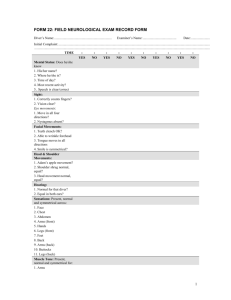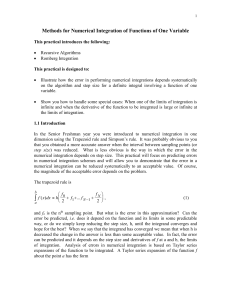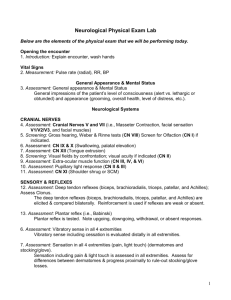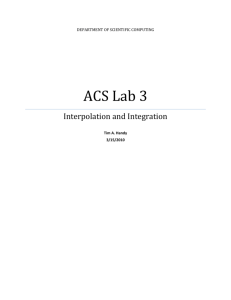Presentation
advertisement
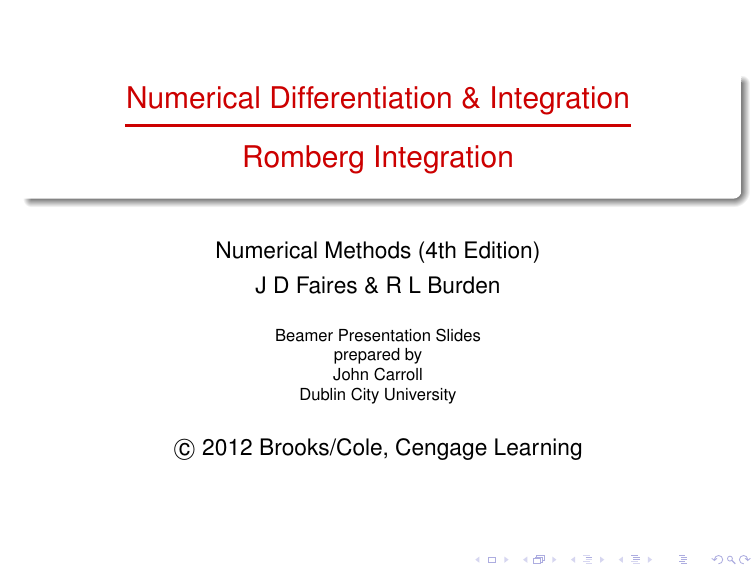
Numerical Differentiation & Integration
Romberg Integration
Numerical Methods (4th Edition)
J D Faires & R L Burden
Beamer Presentation Slides
prepared by
John Carroll
Dublin City University
c 2012 Brooks/Cole, Cengage Learning
Extrapolation
Romberg (Basic)
Romberg (Recursive)
Romberg (Algorithm)
Outline
1
Composite Trapezoidal Rule & Richardson Extrapolation
Numerical Analysis (Chapter 4)
Romberg Integration
J D Faires & R L Burden
2 / 39
Extrapolation
Romberg (Basic)
Romberg (Recursive)
Romberg (Algorithm)
Outline
1
Composite Trapezoidal Rule & Richardson Extrapolation
2
Romberg Integration: Basic Construction
Numerical Analysis (Chapter 4)
Romberg Integration
J D Faires & R L Burden
2 / 39
Extrapolation
Romberg (Basic)
Romberg (Recursive)
Romberg (Algorithm)
Outline
1
Composite Trapezoidal Rule & Richardson Extrapolation
2
Romberg Integration: Basic Construction
3
Romberg Integration: Recursive Calculation
Numerical Analysis (Chapter 4)
Romberg Integration
J D Faires & R L Burden
2 / 39
Extrapolation
Romberg (Basic)
Romberg (Recursive)
Romberg (Algorithm)
Outline
1
Composite Trapezoidal Rule & Richardson Extrapolation
2
Romberg Integration: Basic Construction
3
Romberg Integration: Recursive Calculation
4
Romberg Integration: The Recursive Algorithm
Numerical Analysis (Chapter 4)
Romberg Integration
J D Faires & R L Burden
2 / 39
Extrapolation
Romberg (Basic)
Romberg (Recursive)
Romberg (Algorithm)
Outline
1
Composite Trapezoidal Rule & Richardson Extrapolation
2
Romberg Integration: Basic Construction
3
Romberg Integration: Recursive Calculation
4
Romberg Integration: The Recursive Algorithm
Numerical Analysis (Chapter 4)
Romberg Integration
J D Faires & R L Burden
3 / 39
Extrapolation
Romberg (Basic)
Romberg (Recursive)
Romberg (Algorithm)
Numerical Integration: Basic Romberg Method
Composite Trapezoidal Rule: Error Term
Numerical Analysis (Chapter 4)
Romberg Integration
J D Faires & R L Burden
4 / 39
Extrapolation
Romberg (Basic)
Romberg (Recursive)
Romberg (Algorithm)
Numerical Integration: Basic Romberg Method
Composite Trapezoidal Rule: Error Term
We will illustrate how Richardson extrapolation applied to results
from the Composite Trapezoidal rule can be used to obtain high
accuracy approximations with little computational cost.
Numerical Analysis (Chapter 4)
Romberg Integration
J D Faires & R L Burden
4 / 39
Extrapolation
Romberg (Basic)
Romberg (Recursive)
Romberg (Algorithm)
Numerical Integration: Basic Romberg Method
Composite Trapezoidal Rule: Error Term
We will illustrate how Richardson extrapolation applied to results
from the Composite Trapezoidal rule can be used to obtain high
accuracy approximations with little computational cost.
We have seen that the Composite Trapezoidal rule has a
truncation error of order O(h2 ).
Numerical Analysis (Chapter 4)
Romberg Integration
J D Faires & R L Burden
4 / 39
Extrapolation
Romberg (Basic)
Romberg (Recursive)
Romberg (Algorithm)
Numerical Integration: Basic Romberg Method
Composite Trapezoidal Rule: Error Term
We will illustrate how Richardson extrapolation applied to results
from the Composite Trapezoidal rule can be used to obtain high
accuracy approximations with little computational cost.
We have seen that the Composite Trapezoidal rule has a
truncation error of order O(h2 ). Specifically, we showed that for
h = (b − a)/n and xj = a + jh we have
Z b
n−1
X
(b − a)f 00 (µ) 2
h
f (a) + 2
f (xj ) + f (b) −
h
f (x) dx =
2
12
a
j=1
for some number µ in(a, b).
Numerical Analysis (Chapter 4)
Romberg Integration
J D Faires & R L Burden
4 / 39
Extrapolation
Romberg (Basic)
Romberg (Recursive)
Romberg (Algorithm)
Numerical Integration: Basic Romberg Method
Z
b
f (x) dx =
a
h
f (a) + 2
2
n−1
X
j=1
(b − a)f 00 (µ) 2
f (xj ) + f (b) −
h
12
Composite Trapezoidal Rule: Error Term (Cont’d)
Numerical Analysis (Chapter 4)
Romberg Integration
J D Faires & R L Burden
5 / 39
Extrapolation
Romberg (Basic)
Romberg (Recursive)
Romberg (Algorithm)
Numerical Integration: Basic Romberg Method
Z
b
f (x) dx =
a
h
f (a) + 2
2
n−1
X
j=1
(b − a)f 00 (µ) 2
f (xj ) + f (b) −
h
12
Composite Trapezoidal Rule: Error Term (Cont’d)
By an alternative method, it can be shown that if f ∈ C ∞ [a, b],
Numerical Analysis (Chapter 4)
Romberg Integration
J D Faires & R L Burden
5 / 39
Extrapolation
Romberg (Basic)
Romberg (Recursive)
Romberg (Algorithm)
Numerical Integration: Basic Romberg Method
Z
b
f (x) dx =
a
h
f (a) + 2
2
n−1
X
j=1
(b − a)f 00 (µ) 2
f (xj ) + f (b) −
h
12
Composite Trapezoidal Rule: Error Term (Cont’d)
By an alternative method, it can be shown that if f ∈ C ∞ [a, b], the
Composite Trapezoidal rule can also be written with an error term in
the form
Z b
n−1
X
h
f (x) dx = f (a) + 2
f (xj ) + f (b) + K1 h2 + K2 h4 + K3 h6 + · · ·
2
a
j=1
where each Ki is a constant that depends only on f (2i−1) (a) and
f (2i−1) (b).
Numerical Analysis (Chapter 4)
Romberg Integration
J D Faires & R L Burden
5 / 39
Extrapolation
Romberg (Basic)
Romberg (Recursive)
Romberg (Algorithm)
Numerical Integration: Basic Romberg Method
b
Z
f (x) dx =
a
h
f (a) + 2
2
n−1
X
f (xj ) + f (b) + K1 h2 + K2 h4 + K3 h6 + · · ·
j=1
Applying Richardson Extrapolation
Numerical Analysis (Chapter 4)
Romberg Integration
J D Faires & R L Burden
6 / 39
Extrapolation
Romberg (Basic)
Romberg (Recursive)
Romberg (Algorithm)
Numerical Integration: Basic Romberg Method
b
Z
f (x) dx =
a
h
f (a) + 2
2
n−1
X
f (xj ) + f (b) + K1 h2 + K2 h4 + K3 h6 + · · ·
j=1
Applying Richardson Extrapolation
We have seen that Richardson extrapolation can be performed on
any approximation procedure whose truncation error is of the form
m−1
X
Kj hαj + O(hαm )
j=1
for a collection of constants Kj and when
α1 < α2 < α3 < · · · < αm .
Numerical Analysis (Chapter 4)
Romberg Integration
J D Faires & R L Burden
6 / 39
Extrapolation
Romberg (Basic)
Romberg (Recursive)
Romberg (Algorithm)
Numerical Integration: Basic Romberg Method
Applying Richardson Extrapolation (Cont’d)
In particular, we have seen demonstrations to illustrate how
effective this techniques is when the approximation procedure has
a truncation error with only even powers of h, that is, when the
truncation error has the form:
m−1
X
Kj h2j + O(h2m )
j=1
Numerical Analysis (Chapter 4)
Romberg Integration
J D Faires & R L Burden
7 / 39
Extrapolation
Romberg (Basic)
Romberg (Recursive)
Romberg (Algorithm)
Numerical Integration: Basic Romberg Method
Applying Richardson Extrapolation (Cont’d)
In particular, we have seen demonstrations to illustrate how
effective this techniques is when the approximation procedure has
a truncation error with only even powers of h, that is, when the
truncation error has the form:
m−1
X
Kj h2j + O(h2m )
j=1
Because the Composite Trapezoidal rule has this form, it is an
obvious candidate for extrapolation. This results in a technique
known as Romberg integration.
Numerical Analysis (Chapter 4)
Romberg Integration
J D Faires & R L Burden
7 / 39
Extrapolation
Romberg (Basic)
Romberg (Recursive)
Romberg (Algorithm)
Outline
1
Composite Trapezoidal Rule & Richardson Extrapolation
2
Romberg Integration: Basic Construction
3
Romberg Integration: Recursive Calculation
4
Romberg Integration: The Recursive Algorithm
Numerical Analysis (Chapter 4)
Romberg Integration
J D Faires & R L Burden
8 / 39
Extrapolation
Romberg (Basic)
Romberg (Recursive)
Romberg (Algorithm)
Numerical Integration: Basic Romberg Method
Applying Richardson Extrapolation (Cont’d)
Rb
To approximate the integral a f (x) dx we use the results of the
Composite Trapezoidal Rule with n = 1, 2, 4, 8, 16, . . ., and denote
the resulting approximations, respectively, by R1,1 , R2,1 , R3,1 , etc.
Numerical Analysis (Chapter 4)
Romberg Integration
J D Faires & R L Burden
9 / 39
Extrapolation
Romberg (Basic)
Romberg (Recursive)
Romberg (Algorithm)
Numerical Integration: Basic Romberg Method
Applying Richardson Extrapolation (Cont’d)
Rb
To approximate the integral a f (x) dx we use the results of the
Composite Trapezoidal Rule with n = 1, 2, 4, 8, 16, . . ., and denote
the resulting approximations, respectively, by R1,1 , R2,1 , R3,1 , etc.
We then apply extrapolation in the manner seen before, that is, we
obtain O(h4 ) approximations R2,2 , R3,2 , R4,2 , etc, by
1
Rk ,2 = Rk ,1 + (Rk ,1 − Rk −1,1 ),
3
Numerical Analysis (Chapter 4)
Romberg Integration
for k = 2, 3, . . .
J D Faires & R L Burden
9 / 39
Extrapolation
Romberg (Basic)
Romberg (Recursive)
Romberg (Algorithm)
Numerical Integration: Basic Romberg Method
Applying Richardson Extrapolation (Cont’d)
Rb
To approximate the integral a f (x) dx we use the results of the
Composite Trapezoidal Rule with n = 1, 2, 4, 8, 16, . . ., and denote
the resulting approximations, respectively, by R1,1 , R2,1 , R3,1 , etc.
We then apply extrapolation in the manner seen before, that is, we
obtain O(h4 ) approximations R2,2 , R3,2 , R4,2 , etc, by
1
Rk ,2 = Rk ,1 + (Rk ,1 − Rk −1,1 ),
3
for k = 2, 3, . . .
and O(h6 ) approximations R3,3 , R4,3 , R5,3 , etc, by
Rk ,3 = Rk ,2 +
Numerical Analysis (Chapter 4)
1
(Rk ,2 − Rk −1,2 ),
15
Romberg Integration
for k = 3, 4, . . ..
J D Faires & R L Burden
9 / 39
Extrapolation
Romberg (Basic)
Romberg (Recursive)
Romberg (Algorithm)
Numerical Integration: Basic Romberg Method
Romberg Integration
In general, after the appropriate Rk ,j−1 approximations have been
obtained, we determine the O(h2j ) approximations from
Rk ,j = Rk ,j−1 +
Numerical Analysis (Chapter 4)
1
(Rk ,j−1 − Rk −1,j−1 ),
4j−1 − 1
Romberg Integration
for k = j, j + 1, . . .
J D Faires & R L Burden
10 / 39
Extrapolation
Romberg (Basic)
Romberg (Recursive)
Romberg (Algorithm)
Numerical Integration: Basic Romberg Method
Example: Composite Trapezoidal & Romberg
Use
R π the Composite Trapezoidal rule to find approximations to
0 sin x dx with n = 1, 2, 4, 8, and 16.
Numerical Analysis (Chapter 4)
Romberg Integration
J D Faires & R L Burden
11 / 39
Extrapolation
Romberg (Basic)
Romberg (Recursive)
Romberg (Algorithm)
Numerical Integration: Basic Romberg Method
Example: Composite Trapezoidal & Romberg
Use
R π the Composite Trapezoidal rule to find approximations to
0 sin x dx with n = 1, 2, 4, 8, and 16.
Then perform Romberg extrapolation on the results.
Numerical Analysis (Chapter 4)
Romberg Integration
J D Faires & R L Burden
11 / 39
Extrapolation
Romberg (Basic)
Romberg (Recursive)
Romberg (Algorithm)
Numerical Integration: Basic Romberg Method
Solution (1/6): Composite Trapezoidal Rule Approximations
The Composite Trapezoidal rule for the various values of n gives the
following approximations to the true value 2.
R1,1 =
π
[sin 0 + sin π] = 0
2
Numerical Analysis (Chapter 4)
Romberg Integration
J D Faires & R L Burden
12 / 39
Extrapolation
Romberg (Basic)
Romberg (Recursive)
Romberg (Algorithm)
Numerical Integration: Basic Romberg Method
Solution (1/6): Composite Trapezoidal Rule Approximations
The Composite Trapezoidal rule for the various values of n gives the
following approximations to the true value 2.
R1,1 =
R2,1 =
π
[sin 0 + sin π] = 0
2h
i
π
π
sin 0 + 2 sin + sin π = 1.57079633
4
2
Numerical Analysis (Chapter 4)
Romberg Integration
J D Faires & R L Burden
12 / 39
Extrapolation
Romberg (Basic)
Romberg (Recursive)
Romberg (Algorithm)
Numerical Integration: Basic Romberg Method
Solution (1/6): Composite Trapezoidal Rule Approximations
The Composite Trapezoidal rule for the various values of n gives the
following approximations to the true value 2.
π
[sin 0 + sin π] = 0
2h
i
π
π
=
sin 0 + 2 sin + sin π = 1.57079633
4
2
π
π
π
3π
=
sin 0 + 2 sin + sin + sin
+ sin π
8
4
2
4
= 1.89611890
R1,1 =
R2,1
R3,1
Numerical Analysis (Chapter 4)
Romberg Integration
J D Faires & R L Burden
12 / 39
Extrapolation
Romberg (Basic)
Romberg (Recursive)
Romberg (Algorithm)
Numerical Integration: Basic Romberg Method
Solution (2/6): Composite Trapezoidal Rule Approximations
R4,1 =
π
π
π
3π
7π
sin 0 + 2 sin + sin + · · · + sin
+ sin
16
8
4
4
8
+ sin π] = 1.97423160
Numerical Analysis (Chapter 4)
Romberg Integration
J D Faires & R L Burden
13 / 39
Extrapolation
Romberg (Basic)
Romberg (Recursive)
Romberg (Algorithm)
Numerical Integration: Basic Romberg Method
Solution (2/6): Composite Trapezoidal Rule Approximations
R4,1 =
R5,1 =
π
π
π
3π
7π
sin 0 + 2 sin + sin + · · · + sin
+ sin
16
8
4
4
8
+ sin π] = 1.97423160
π
π
π
7π
15π
sin 0 + 2 sin
+ sin + · · · + sin
+ sin
32
16
8
8
16
+ sin π] = 1.99357034
Numerical Analysis (Chapter 4)
Romberg Integration
J D Faires & R L Burden
13 / 39
Extrapolation
Romberg (Basic)
Romberg (Recursive)
Romberg (Algorithm)
Numerical Integration: Basic Romberg Method
Solution (3/6): Romberg Extrapolation
The O(h4 ) approximations are
Numerical Analysis (Chapter 4)
Romberg Integration
J D Faires & R L Burden
14 / 39
Extrapolation
Romberg (Basic)
Romberg (Recursive)
Romberg (Algorithm)
Numerical Integration: Basic Romberg Method
Solution (3/6): Romberg Extrapolation
The O(h4 ) approximations are
1
R2,2 = R2,1 + (R2,1 − R1,1 ) = 2.09439511
3
Numerical Analysis (Chapter 4)
Romberg Integration
J D Faires & R L Burden
14 / 39
Extrapolation
Romberg (Basic)
Romberg (Recursive)
Romberg (Algorithm)
Numerical Integration: Basic Romberg Method
Solution (3/6): Romberg Extrapolation
The O(h4 ) approximations are
1
R2,2 = R2,1 + (R2,1 − R1,1 ) = 2.09439511
3
1
R3,2 = R3,1 + (R3,1 − R2,1 ) = 2.00455976
3
Numerical Analysis (Chapter 4)
Romberg Integration
J D Faires & R L Burden
14 / 39
Extrapolation
Romberg (Basic)
Romberg (Recursive)
Romberg (Algorithm)
Numerical Integration: Basic Romberg Method
Solution (3/6): Romberg Extrapolation
The O(h4 ) approximations are
1
R2,2 = R2,1 + (R2,1 − R1,1 ) = 2.09439511
3
1
R3,2 = R3,1 + (R3,1 − R2,1 ) = 2.00455976
3
1
R4,2 = R4,1 + (R4,1 − R3,1 ) = 2.00026917
3
Numerical Analysis (Chapter 4)
Romberg Integration
J D Faires & R L Burden
14 / 39
Extrapolation
Romberg (Basic)
Romberg (Recursive)
Romberg (Algorithm)
Numerical Integration: Basic Romberg Method
Solution (3/6): Romberg Extrapolation
The O(h4 ) approximations are
1
R2,2 = R2,1 + (R2,1 − R1,1 ) = 2.09439511
3
1
R3,2 = R3,1 + (R3,1 − R2,1 ) = 2.00455976
3
1
R4,2 = R4,1 + (R4,1 − R3,1 ) = 2.00026917
3
1
R5,2 = R5,1 + (R5,1 − R4,1 ) = 2.00001659
3
Numerical Analysis (Chapter 4)
Romberg Integration
J D Faires & R L Burden
14 / 39
Extrapolation
Romberg (Basic)
Romberg (Recursive)
Romberg (Algorithm)
Numerical Integration: Basic Romberg Method
Solution (4/6): Romberg Extrapolation
The O(h6 ) approximations are
Numerical Analysis (Chapter 4)
Romberg Integration
J D Faires & R L Burden
15 / 39
Extrapolation
Romberg (Basic)
Romberg (Recursive)
Romberg (Algorithm)
Numerical Integration: Basic Romberg Method
Solution (4/6): Romberg Extrapolation
The O(h6 ) approximations are
1
(R3,2 − R2,2 ) = 1.99857073
15
1
= R4,2 +
(R4,2 − R3,2 ) = 1.99998313
15
1
= R5,2 +
(R5,2 − R4,2 ) = 1.99999975
15
R3,3 = R3,2 +
R4,3
R5,3
Numerical Analysis (Chapter 4)
Romberg Integration
J D Faires & R L Burden
15 / 39
Extrapolation
Romberg (Basic)
Romberg (Recursive)
Romberg (Algorithm)
Numerical Integration: Basic Romberg Method
Solution (5/6): Romberg Extrapolation
The two O(h8 ) approximations are
Numerical Analysis (Chapter 4)
Romberg Integration
J D Faires & R L Burden
16 / 39
Extrapolation
Romberg (Basic)
Romberg (Recursive)
Romberg (Algorithm)
Numerical Integration: Basic Romberg Method
Solution (5/6): Romberg Extrapolation
The two O(h8 ) approximations are
1
(R4,3 − R3,3 ) = 2.00000555
63
1
= R5,3 +
(R5,3 − R4,3 ) = 2.00000001
63
R4,4 = R4,3 +
R5,4
and the final O(h10 ) approximation is
R5,5 = R5,4 +
1
(R5,4 − R4,4 ) = 1.99999999
255
These results are shown in the following table.
Numerical Analysis (Chapter 4)
Romberg Integration
J D Faires & R L Burden
16 / 39
Extrapolation
Romberg (Basic)
Romberg (Recursive)
Romberg (Algorithm)
Numerical Integration: Basic Romberg Method
Solution (6/6): Tabulated Extrapolation Results
0
1.57079633
1.89611890
1.97423160
1.99357034
2.09439511
2.00455976 1.99857073
2.00026917 1.99998313 2.00000555
2.00001659 1.99999975 2.00000001 1.99999999
Numerical Analysis (Chapter 4)
Romberg Integration
J D Faires & R L Burden
17 / 39
Extrapolation
Romberg (Basic)
Romberg (Recursive)
Romberg (Algorithm)
Outline
1
Composite Trapezoidal Rule & Richardson Extrapolation
2
Romberg Integration: Basic Construction
3
Romberg Integration: Recursive Calculation
4
Romberg Integration: The Recursive Algorithm
Numerical Analysis (Chapter 4)
Romberg Integration
J D Faires & R L Burden
18 / 39
Extrapolation
Romberg (Basic)
Romberg (Recursive)
Romberg (Algorithm)
Romberg Integration Recursive Calculation
A More Efficient Implementation
Notice that when generating the approximations for the Composite
Trapezoidal Rule approximations in the last example, each
consecutive approximation included all the functions evaluations
from the previous approximation.
Numerical Analysis (Chapter 4)
Romberg Integration
J D Faires & R L Burden
19 / 39
Extrapolation
Romberg (Basic)
Romberg (Recursive)
Romberg (Algorithm)
Romberg Integration Recursive Calculation
A More Efficient Implementation
Notice that when generating the approximations for the Composite
Trapezoidal Rule approximations in the last example, each
consecutive approximation included all the functions evaluations
from the previous approximation.
That is, R1,1 used evaluations at 0 and π, R2,1 used these
evaluations and added an evaluation at the intermediate point π/2.
Numerical Analysis (Chapter 4)
Romberg Integration
J D Faires & R L Burden
19 / 39
Extrapolation
Romberg (Basic)
Romberg (Recursive)
Romberg (Algorithm)
Romberg Integration Recursive Calculation
A More Efficient Implementation
Notice that when generating the approximations for the Composite
Trapezoidal Rule approximations in the last example, each
consecutive approximation included all the functions evaluations
from the previous approximation.
That is, R1,1 used evaluations at 0 and π, R2,1 used these
evaluations and added an evaluation at the intermediate point π/2.
Then R3,1 used the evaluations of R2,1 and added two additional
intermediate ones at π/4 and 3π/4.
Numerical Analysis (Chapter 4)
Romberg Integration
J D Faires & R L Burden
19 / 39
Extrapolation
Romberg (Basic)
Romberg (Recursive)
Romberg (Algorithm)
Romberg Integration Recursive Calculation
A More Efficient Implementation
Notice that when generating the approximations for the Composite
Trapezoidal Rule approximations in the last example, each
consecutive approximation included all the functions evaluations
from the previous approximation.
That is, R1,1 used evaluations at 0 and π, R2,1 used these
evaluations and added an evaluation at the intermediate point π/2.
Then R3,1 used the evaluations of R2,1 and added two additional
intermediate ones at π/4 and 3π/4.
This pattern continues with R4,1 using the same evaluations as
R3,1 but adding evaluations at the 4 intermediate points π/8, 3π/8,
5π/8, and 7π/8, and so on.
Numerical Analysis (Chapter 4)
Romberg Integration
J D Faires & R L Burden
19 / 39
Extrapolation
Romberg (Basic)
Romberg (Recursive)
Romberg (Algorithm)
Romberg Integration: Recursive Calculation
A More Efficient Implementation (Cont’d)
This evaluation procedure for Composite Trapezoidal Rule
approximations holds for an integral on any interval [a, b].
Numerical Analysis (Chapter 4)
Romberg Integration
J D Faires & R L Burden
20 / 39
Extrapolation
Romberg (Basic)
Romberg (Recursive)
Romberg (Algorithm)
Romberg Integration: Recursive Calculation
A More Efficient Implementation (Cont’d)
This evaluation procedure for Composite Trapezoidal Rule
approximations holds for an integral on any interval [a, b].
In general, the Composite Trapezoidal Rule denoted Rk +1,1 uses
the same evaluations as Rk ,1 but adds evaluations at the 2k −2
intermediate points.
Numerical Analysis (Chapter 4)
Romberg Integration
J D Faires & R L Burden
20 / 39
Extrapolation
Romberg (Basic)
Romberg (Recursive)
Romberg (Algorithm)
Romberg Integration: Recursive Calculation
A More Efficient Implementation (Cont’d)
This evaluation procedure for Composite Trapezoidal Rule
approximations holds for an integral on any interval [a, b].
In general, the Composite Trapezoidal Rule denoted Rk +1,1 uses
the same evaluations as Rk ,1 but adds evaluations at the 2k −2
intermediate points.
Efficient calculation of these approximations can therefore be
done in a recursive manner.
Numerical Analysis (Chapter 4)
Romberg Integration
J D Faires & R L Burden
20 / 39
Extrapolation
Romberg (Basic)
Romberg (Recursive)
Romberg (Algorithm)
Romberg Integration: Recursive Calculation (Cont’d)
Formulating a Recursive Algorithm
To obtain the Composite Trapezoidal Rule approximations for
Rb
k −1 .
a f (x) dx, let hk = (b − a)/mk = (b − a)/2
Numerical Analysis (Chapter 4)
Romberg Integration
J D Faires & R L Burden
21 / 39
Extrapolation
Romberg (Basic)
Romberg (Recursive)
Romberg (Algorithm)
Romberg Integration: Recursive Calculation (Cont’d)
Formulating a Recursive Algorithm
To obtain the Composite Trapezoidal Rule approximations for
Rb
k −1 . Then
a f (x) dx, let hk = (b − a)/mk = (b − a)/2
R1,1 =
h1
(b − a)
[f (a) + f (b)] =
[f (a) + f (b)]
2
2
and
Numerical Analysis (Chapter 4)
Romberg Integration
J D Faires & R L Burden
21 / 39
Extrapolation
Romberg (Basic)
Romberg (Recursive)
Romberg (Algorithm)
Romberg Integration: Recursive Calculation (Cont’d)
Formulating a Recursive Algorithm
To obtain the Composite Trapezoidal Rule approximations for
Rb
k −1 . Then
a f (x) dx, let hk = (b − a)/mk = (b − a)/2
R1,1 =
and
R2,1 =
Numerical Analysis (Chapter 4)
h1
(b − a)
[f (a) + f (b)] =
[f (a) + f (b)]
2
2
h2
[f (a) + f (b) + 2f (a + h2 )]
2
Romberg Integration
J D Faires & R L Burden
21 / 39
Extrapolation
Romberg (Basic)
Romberg (Recursive)
Romberg (Algorithm)
Romberg Integration: Recursive Calculation (Cont’d)
Formulating a Recursive Algorithm
To obtain the Composite Trapezoidal Rule approximations for
Rb
k −1 . Then
a f (x) dx, let hk = (b − a)/mk = (b − a)/2
R1,1 =
and
R2,1 =
h1
(b − a)
[f (a) + f (b)] =
[f (a) + f (b)]
2
2
h2
[f (a) + f (b) + 2f (a + h2 )]
2
By re-expressing this result for R2,1 we can incorporate the previously
determined approximation R1,1
(b − a)
(b − a)
1
R2,1 =
f (a) + f (b) + 2f a +
= [R1,1 +h1 f (a+h2 )]
4
2
2
Numerical Analysis (Chapter 4)
Romberg Integration
J D Faires & R L Burden
21 / 39
Extrapolation
Romberg (Basic)
Romberg (Recursive)
Romberg (Algorithm)
Romberg Integration: Recursive Calculation (Cont’d)
Formulating a Recursive Algorithm
In a similar manner we can write
R3,1 =
and, in general
1
{R2,1 + h2 [f (a + h3 ) + f (a + 3h3 )]}
2
See Diagram
, we have
Rk ,1 =
1
Rk −1,1 + hk −1
2
k −2
2X
f (a + (2i − 1)hk )
i=1
for each k = 2, 3, . . . , n.
Numerical Analysis (Chapter 4)
Romberg Integration
J D Faires & R L Burden
22 / 39
Extrapolation
Romberg (Basic)
Romberg (Recursive)
Romberg (Algorithm)
Romberg Integration: Recursive Calculation (Cont’d)
Extrapolation then is used to produce O(hk2j ) approximations by
Romberg Method
Rk ,j = Rk ,j−1 +
1
(Rk ,j−1 − Rk −1,j−1 )
−1
4j−1
for k = j, j + 1, . . ..
as shown in the following table.
Numerical Analysis (Chapter 4)
Romberg Integration
J D Faires & R L Burden
23 / 39
Extrapolation
Romberg (Basic)
Romberg (Recursive)
Romberg (Algorithm)
Romberg Integration: Recursive Calculation (Cont’d)
Rk ,j = Rk ,j−1 +
1
(Rk ,j−1 − Rk −1,j−1 )
−1
4j−1
for k = j, j + 1, . . ..
The Romberg Table
k O hk2
O hk4
O hk6
O hk8
1
2
3
4
..
.
R1,1
R2,1
R3,1
R4,1
..
.
R2,2
R3,2
R4,2
..
.
R3,3
R4,3
..
.
R4,4
..
.
n
Rn,1
Rn,2
Rn,3
Rn,4
Numerical Analysis (Chapter 4)
Romberg Integration
O hk2n
..
.
···
Rn,n
J D Faires & R L Burden
24 / 39
Extrapolation
Romberg (Basic)
Romberg (Recursive)
Romberg (Algorithm)
Romberg Integration: Recursive Calculation
Constructing the Romberg Table: One Row at a Time
The effective method to construct the Romberg table makes use
of the highest order of approximation at each step.
Numerical Analysis (Chapter 4)
Romberg Integration
J D Faires & R L Burden
25 / 39
Extrapolation
Romberg (Basic)
Romberg (Recursive)
Romberg (Algorithm)
Romberg Integration: Recursive Calculation
Constructing the Romberg Table: One Row at a Time
The effective method to construct the Romberg table makes use
of the highest order of approximation at each step.
That is, it calculates the entries row by row, in the order R1,1 , R2,1 ,
R2,2 , R3,1 , R3,2 , R3,3 , etc.
Numerical Analysis (Chapter 4)
Romberg Integration
J D Faires & R L Burden
25 / 39
Extrapolation
Romberg (Basic)
Romberg (Recursive)
Romberg (Algorithm)
Romberg Integration: Recursive Calculation
Constructing the Romberg Table: One Row at a Time
The effective method to construct the Romberg table makes use
of the highest order of approximation at each step.
That is, it calculates the entries row by row, in the order R1,1 , R2,1 ,
R2,2 , R3,1 , R3,2 , R3,3 , etc.
This also permits an entire new row in the table to be calculated
by doing only one additional application of the Composite
Trapezoidal rule.
Numerical Analysis (Chapter 4)
Romberg Integration
J D Faires & R L Burden
25 / 39
Extrapolation
Romberg (Basic)
Romberg (Recursive)
Romberg (Algorithm)
Romberg Integration: Recursive Calculation
Constructing the Romberg Table: One Row at a Time
The effective method to construct the Romberg table makes use
of the highest order of approximation at each step.
That is, it calculates the entries row by row, in the order R1,1 , R2,1 ,
R2,2 , R3,1 , R3,2 , R3,3 , etc.
This also permits an entire new row in the table to be calculated
by doing only one additional application of the Composite
Trapezoidal rule.
It then uses a simple averaging on the previously calculated
values to obtain the remaining entries in the row.
Numerical Analysis (Chapter 4)
Romberg Integration
J D Faires & R L Burden
25 / 39
Extrapolation
Romberg (Basic)
Romberg (Recursive)
Romberg (Algorithm)
Romberg Integration: Recursive Calculation
Constructing the Romberg Table: One Row at a Time
The effective method to construct the Romberg table makes use
of the highest order of approximation at each step.
That is, it calculates the entries row by row, in the order R1,1 , R2,1 ,
R2,2 , R3,1 , R3,2 , R3,3 , etc.
This also permits an entire new row in the table to be calculated
by doing only one additional application of the Composite
Trapezoidal rule.
It then uses a simple averaging on the previously calculated
values to obtain the remaining entries in the row.
Calculate the Romberg table one complete row at a time.
Numerical Analysis (Chapter 4)
Romberg Integration
J D Faires & R L Burden
25 / 39
Extrapolation
Romberg (Basic)
Romberg (Recursive)
Romberg (Algorithm)
Romberg Integration: Recursive Calculation
Example: Extending the Romberg Table
Add an additional extrapolation row to the Romberg table of the
previous example:
0
1.57079633
1.89611890
1.97423160
1.99357034
2.09439511
2.00455976 1.99857073
2.00026917 1.99998313 2.00000555
2.00001659 1.99999975 2.00000001 1.99999999
to approximate
Rπ
0
sin x dx.
Numerical Analysis (Chapter 4)
Romberg Integration
J D Faires & R L Burden
26 / 39
Extrapolation
Romberg (Basic)
Romberg (Recursive)
Romberg (Algorithm)
Romberg Integration: Recursive Calculation
Solution (1/4): Generate Additional Row of the Table
To obtain the additional row we need the trapezoidal approximation
24
X
π
(2k − 1)π
1
sin
= 1.99839336
R6,1 = R5,1 +
2
16
32
k =1
Numerical Analysis (Chapter 4)
Romberg Integration
J D Faires & R L Burden
27 / 39
Extrapolation
Romberg (Basic)
Romberg (Recursive)
Romberg (Algorithm)
Solution (2/4): Generate New Row Values of the Romberg Table
The values of the new row
Numerical Analysis (Chapter 4)
(See Table)
are as follows:
Romberg Integration
J D Faires & R L Burden
28 / 39
Extrapolation
Romberg (Basic)
Romberg (Recursive)
Romberg (Algorithm)
Solution (2/4): Generate New Row Values of the Romberg Table
The values of the new row
(See Table)
are as follows:
1
R6,2 = R6,1 + (R6,1 − R5,1 )
3
Numerical Analysis (Chapter 4)
Romberg Integration
J D Faires & R L Burden
28 / 39
Extrapolation
Romberg (Basic)
Romberg (Recursive)
Romberg (Algorithm)
Solution (2/4): Generate New Row Values of the Romberg Table
The values of the new row
(See Table)
are as follows:
1
R6,2 = R6,1 + (R6,1 − R5,1 )
3
1
= 1.99839336 + (1.99839336 − 1.99357035) = 2.00000103
3
Numerical Analysis (Chapter 4)
Romberg Integration
J D Faires & R L Burden
28 / 39
Extrapolation
Romberg (Basic)
Romberg (Recursive)
Romberg (Algorithm)
Solution (2/4): Generate New Row Values of the Romberg Table
The values of the new row
(See Table)
are as follows:
1
R6,2 = R6,1 + (R6,1 − R5,1 )
3
1
= 1.99839336 + (1.99839336 − 1.99357035) = 2.00000103
3
1
(R6,2 − R5,2 )
R6,3 = R6,2 +
15
Numerical Analysis (Chapter 4)
Romberg Integration
J D Faires & R L Burden
28 / 39
Extrapolation
Romberg (Basic)
Romberg (Recursive)
Romberg (Algorithm)
Solution (2/4): Generate New Row Values of the Romberg Table
The values of the new row
(See Table)
are as follows:
1
R6,2 = R6,1 + (R6,1 − R5,1 )
3
1
= 1.99839336 + (1.99839336 − 1.99357035) = 2.00000103
3
1
(R6,2 − R5,2 )
R6,3 = R6,2 +
15
1
(2.00000103 − 2.00001659) = 2.00000000
= 2.00000103 +
15
Numerical Analysis (Chapter 4)
Romberg Integration
J D Faires & R L Burden
28 / 39
Extrapolation
Romberg (Basic)
Romberg (Recursive)
Romberg (Algorithm)
Solution (2/4): Generate New Row Values of the Romberg Table
The values of the new row
(See Table)
are as follows:
1
R6,2 = R6,1 + (R6,1 − R5,1 )
3
1
= 1.99839336 + (1.99839336 − 1.99357035) = 2.00000103
3
1
(R6,2 − R5,2 )
R6,3 = R6,2 +
15
1
(2.00000103 − 2.00001659) = 2.00000000
= 2.00000103 +
15
1
(R6,3 − R5,3 ) = 2.00000000
R6,4 = R6,3 +
63
Numerical Analysis (Chapter 4)
Romberg Integration
J D Faires & R L Burden
28 / 39
Extrapolation
Romberg (Basic)
Romberg (Recursive)
Romberg (Algorithm)
Solution (2/4): Generate New Row Values of the Romberg Table
The values of the new row
(See Table)
are as follows:
1
R6,2 = R6,1 + (R6,1 − R5,1 )
3
1
= 1.99839336 + (1.99839336 − 1.99357035) = 2.00000103
3
1
(R6,2 − R5,2 )
R6,3 = R6,2 +
15
1
(2.00000103 − 2.00001659) = 2.00000000
= 2.00000103 +
15
1
(R6,3 − R5,3 ) = 2.00000000
R6,4 = R6,3 +
63
1
R6,5 = R6,4 +
(R6,4 − R5,4 ) = 2.00000000
255
Numerical Analysis (Chapter 4)
Romberg Integration
J D Faires & R L Burden
28 / 39
Extrapolation
Romberg (Basic)
Romberg (Recursive)
Romberg (Algorithm)
Solution (2/4): Generate New Row Values of the Romberg Table
The values of the new row
(See Table)
are as follows:
1
R6,2 = R6,1 + (R6,1 − R5,1 )
3
1
= 1.99839336 + (1.99839336 − 1.99357035) = 2.00000103
3
1
(R6,2 − R5,2 )
R6,3 = R6,2 +
15
1
(2.00000103 − 2.00001659) = 2.00000000
= 2.00000103 +
15
1
(R6,3 − R5,3 ) = 2.00000000
R6,4 = R6,3 +
63
1
R6,5 = R6,4 +
(R6,4 − R5,4 ) = 2.00000000
255
1
R6,6 = R6,5 +
(R6,5 − R5,5 ) = 2.00000000
1023
and
Numerical Analysis
(Chapter 4)
Romberg Integration
J D Faires & R L Burden
28 / 39
Extrapolation
Romberg (Basic)
Romberg (Recursive)
Romberg (Algorithm)
Romberg Integration: Recursive Calculation
Solution (3/4): The Final Extrapolation Table
0
1.57079633
1.89611890
1.97423160
1.99357034
1.99839336
2.09439511
2.00455976
2.00026917
2.00001659
2.00000103
Numerical Analysis (Chapter 4)
1.99857073
1.99998313
1.99999975
2.00000000
2.00000555
2.00000001
2.00000000
Romberg Integration
1.99999999
2.00000000
2.00000000
J D Faires & R L Burden
29 / 39
Extrapolation
Romberg (Basic)
Romberg (Recursive)
Romberg (Algorithm)
Romberg Integration: Recursive Calculation
Solution (4/4): Comments on the Numerical Results
Notice that all the extrapolated values except for the first (in the
first row of the second column) are more accurate than the best
composite trapezoidal approximation (in the last row of the first
column).
Numerical Analysis (Chapter 4)
Romberg Integration
J D Faires & R L Burden
30 / 39
Extrapolation
Romberg (Basic)
Romberg (Recursive)
Romberg (Algorithm)
Romberg Integration: Recursive Calculation
Solution (4/4): Comments on the Numerical Results
Notice that all the extrapolated values except for the first (in the
first row of the second column) are more accurate than the best
composite trapezoidal approximation (in the last row of the first
column).
Although there are 21 entries in the table, only the six in the left
column require function evaluations since these are the only
entries generated by the Composite Trapezoidal rule; the other
entries are obtained by an averaging process.
Numerical Analysis (Chapter 4)
Romberg Integration
J D Faires & R L Burden
30 / 39
Extrapolation
Romberg (Basic)
Romberg (Recursive)
Romberg (Algorithm)
Romberg Integration: Recursive Calculation
Solution (4/4): Comments on the Numerical Results
Notice that all the extrapolated values except for the first (in the
first row of the second column) are more accurate than the best
composite trapezoidal approximation (in the last row of the first
column).
Although there are 21 entries in the table, only the six in the left
column require function evaluations since these are the only
entries generated by the Composite Trapezoidal rule; the other
entries are obtained by an averaging process.
In fact, because of the recurrence relationship of the terms in the
left column, the only function evaluations needed are those to
compute the final Composite Trapezoidal rule approximation.
Numerical Analysis (Chapter 4)
Romberg Integration
J D Faires & R L Burden
30 / 39
Extrapolation
Romberg (Basic)
Romberg (Recursive)
Romberg (Algorithm)
Romberg Integration: Recursive Calculation
Solution (4/4): Comments on the Numerical Results
Notice that all the extrapolated values except for the first (in the
first row of the second column) are more accurate than the best
composite trapezoidal approximation (in the last row of the first
column).
Although there are 21 entries in the table, only the six in the left
column require function evaluations since these are the only
entries generated by the Composite Trapezoidal rule; the other
entries are obtained by an averaging process.
In fact, because of the recurrence relationship of the terms in the
left column, the only function evaluations needed are those to
compute the final Composite Trapezoidal rule approximation.
In general, Rk ,1 requires 1 + 2k −1 function evaluations, so in this
case 1 + 25 = 33 are needed.
Numerical Analysis (Chapter 4)
Romberg Integration
J D Faires & R L Burden
30 / 39
Extrapolation
Romberg (Basic)
Romberg (Recursive)
Romberg (Algorithm)
Outline
1
Composite Trapezoidal Rule & Richardson Extrapolation
2
Romberg Integration: Basic Construction
3
Romberg Integration: Recursive Calculation
4
Romberg Integration: The Recursive Algorithm
Numerical Analysis (Chapter 4)
Romberg Integration
J D Faires & R L Burden
31 / 39
Extrapolation
Romberg (Basic)
Romberg (Recursive)
Romberg (Algorithm)
The Romberg Algorithm
Z
To approximate the integral I =
b
f (x) dx, select an integer n > 0.
a
INPUT
OUTPUT
endpoints a, b; integer n.
an array R (compute R by rows; only the last 2 rows are
saved in storage).
Numerical Analysis (Chapter 4)
Romberg Integration
J D Faires & R L Burden
32 / 39
Extrapolation
Romberg (Basic)
Romberg (Recursive)
Romberg (Algorithm)
The Romberg Algorithm
Z
To approximate the integral I =
b
f (x) dx, select an integer n > 0.
a
INPUT
OUTPUT
Step 1
endpoints a, b; integer n.
an array R (compute R by rows; only the last 2 rows are
saved in storage).
Set h = b − a
R1,1 = h2 (f (a) + f (b))
Numerical Analysis (Chapter 4)
Romberg Integration
J D Faires & R L Burden
32 / 39
Extrapolation
Romberg (Basic)
Romberg (Recursive)
Romberg (Algorithm)
The Romberg Algorithm
Z
To approximate the integral I =
b
f (x) dx, select an integer n > 0.
a
INPUT
OUTPUT
Step 1
Step 2
endpoints a, b; integer n.
an array R (compute R by rows; only the last 2 rows are
saved in storage).
Set h = b − a
R1,1 = h2 (f (a) + f (b))
OUTPUT (R1,1 )
Numerical Analysis (Chapter 4)
Romberg Integration
J D Faires & R L Burden
32 / 39
Extrapolation
Romberg (Basic)
Romberg (Recursive)
Romberg (Algorithm)
The Romberg Algorithm
Z
To approximate the integral I =
b
f (x) dx, select an integer n > 0.
a
INPUT
OUTPUT
Step 1
Step 2
endpoints a, b; integer n.
an array R (compute R by rows; only the last 2 rows are
saved in storage).
Set h = b − a
R1,1 = h2 (f (a) + f (b))
OUTPUT (R1,1 )
Steps 3 to 9 are on the next slide
Numerical Analysis (Chapter 4)
Romberg Integration
J D Faires & R L Burden
32 / 39
Extrapolation
Romberg (Basic)
Romberg (Recursive)
Romberg (Algorithm)
The Romberg Algorithm
Step 3
For i = 2, . . . , n do Steps 4–8:
Numerical Analysis (Chapter 4)
Romberg Integration
J D Faires & R L Burden
33 / 39
Extrapolation
Romberg (Basic)
Romberg (Recursive)
Romberg (Algorithm)
The Romberg Algorithm
Step 3
For i = 2, . . . , n do Steps 4–8:
Step 4
i−2
2
X
1
f (a + (k − 0.5)h)
Set R2,1 = R1,1 + h
2
k =1
(Approximation from the Trapezoidal method)
Numerical Analysis (Chapter 4)
Romberg Integration
J D Faires & R L Burden
33 / 39
Extrapolation
Romberg (Basic)
Romberg (Recursive)
Romberg (Algorithm)
The Romberg Algorithm
Step 3
For i = 2, . . . , n do Steps 4–8:
Step 4
i−2
2
X
1
f (a + (k − 0.5)h)
Set R2,1 = R1,1 + h
2
k =1
(Approximation from the Trapezoidal method)
Step 5 For j = 2, . . . , i
R2,j−1 − R1,j−1
set R2,j = R2,j−1 +
(Extrapolation)
4 j−1 − 1
Numerical Analysis (Chapter 4)
Romberg Integration
J D Faires & R L Burden
33 / 39
Extrapolation
Romberg (Basic)
Romberg (Recursive)
Romberg (Algorithm)
The Romberg Algorithm
Step 3
For i = 2, . . . , n do Steps 4–8:
Step 4
i−2
2
X
1
f (a + (k − 0.5)h)
Set R2,1 = R1,1 + h
2
k =1
(Approximation from the Trapezoidal method)
Step 5 For j = 2, . . . , i
R2,j−1 − R1,j−1
set R2,j = R2,j−1 +
(Extrapolation)
4 j−1 − 1
Step 6 OUTPUT (R2,j for j = 1, 2, . . . , i)
Numerical Analysis (Chapter 4)
Romberg Integration
J D Faires & R L Burden
33 / 39
Extrapolation
Romberg (Basic)
Romberg (Recursive)
Romberg (Algorithm)
The Romberg Algorithm
Step 3
For i = 2, . . . , n do Steps 4–8:
Step 4
i−2
2
X
1
f (a + (k − 0.5)h)
Set R2,1 = R1,1 + h
2
k =1
(Approximation from the Trapezoidal method)
Step 5 For j = 2, . . . , i
R2,j−1 − R1,j−1
set R2,j = R2,j−1 +
(Extrapolation)
4 j−1 − 1
Step 6 OUTPUT (R2,j for j = 1, 2, . . . , i)
Step 7 Set h = h/2
Numerical Analysis (Chapter 4)
Romberg Integration
J D Faires & R L Burden
33 / 39
Extrapolation
Romberg (Basic)
Romberg (Recursive)
Romberg (Algorithm)
The Romberg Algorithm
Step 3
For i = 2, . . . , n do Steps 4–8:
Step 4
i−2
2
X
1
f (a + (k − 0.5)h)
Set R2,1 = R1,1 + h
2
k =1
(Approximation from the Trapezoidal method)
Step 5 For j = 2, . . . , i
R2,j−1 − R1,j−1
set R2,j = R2,j−1 +
(Extrapolation)
4 j−1 − 1
Step 6 OUTPUT (R2,j for j = 1, 2, . . . , i)
Step 7 Set h = h/2
Step 8 For j = 1, 2, . . . , i set R1,j = R2,j
(Update row 1 of R)
Numerical Analysis (Chapter 4)
Romberg Integration
J D Faires & R L Burden
33 / 39
Extrapolation
Romberg (Basic)
Romberg (Recursive)
Romberg (Algorithm)
The Romberg Algorithm
Step 3
For i = 2, . . . , n do Steps 4–8:
Step 4
i−2
2
X
1
f (a + (k − 0.5)h)
Set R2,1 = R1,1 + h
2
k =1
(Approximation from the Trapezoidal method)
Step 5 For j = 2, . . . , i
R2,j−1 − R1,j−1
set R2,j = R2,j−1 +
(Extrapolation)
4 j−1 − 1
Step 6 OUTPUT (R2,j for j = 1, 2, . . . , i)
Step 7 Set h = h/2
Step 8 For j = 1, 2, . . . , i set R1,j = R2,j
(Update row 1 of R)
Step 9
STOP
Numerical Analysis (Chapter 4)
Romberg Integration
J D Faires & R L Burden
33 / 39
Extrapolation
Romberg (Basic)
Romberg (Recursive)
Romberg (Algorithm)
The Romberg Algorithm
Comments on the Algorithm (1/2)
Numerical Analysis (Chapter 4)
Romberg Integration
J D Faires & R L Burden
34 / 39
Extrapolation
Romberg (Basic)
Romberg (Recursive)
Romberg (Algorithm)
The Romberg Algorithm
Comments on the Algorithm (1/2)
The algorithm requires a preset integer n to determine the number
of rows to be generated.
Numerical Analysis (Chapter 4)
Romberg Integration
J D Faires & R L Burden
34 / 39
Extrapolation
Romberg (Basic)
Romberg (Recursive)
Romberg (Algorithm)
The Romberg Algorithm
Comments on the Algorithm (1/2)
The algorithm requires a preset integer n to determine the number
of rows to be generated.
We could also set an error tolerance for the approximation and
generate n, within some upper bound, until consecutive diagonal
entries Rn−1,n−1 and Rn,n agree to within the tolerance.
Numerical Analysis (Chapter 4)
Romberg Integration
J D Faires & R L Burden
34 / 39
Extrapolation
Romberg (Basic)
Romberg (Recursive)
Romberg (Algorithm)
The Romberg Algorithm
Comments on the Algorithm (2/2)
Numerical Analysis (Chapter 4)
Romberg Integration
J D Faires & R L Burden
35 / 39
Extrapolation
Romberg (Basic)
Romberg (Recursive)
Romberg (Algorithm)
The Romberg Algorithm
Comments on the Algorithm (2/2)
To guard against the possibility that two consecutive row elements
agree with each other but not with the value of the integral being
approximated, it is common to generate approximations until not
only
Rn−1,n−1 − Rn,n is within the tolerance, but also
Rn−2,n−2 − Rn−1,n−1 Numerical Analysis (Chapter 4)
Romberg Integration
J D Faires & R L Burden
35 / 39
Extrapolation
Romberg (Basic)
Romberg (Recursive)
Romberg (Algorithm)
The Romberg Algorithm
Comments on the Algorithm (2/2)
To guard against the possibility that two consecutive row elements
agree with each other but not with the value of the integral being
approximated, it is common to generate approximations until not
only
Rn−1,n−1 − Rn,n is within the tolerance, but also
Rn−2,n−2 − Rn−1,n−1 Although not a universal safeguard, this will ensure that two
differently generated sets of approximations agree within the
specified tolerance before Rn,n , is accepted as sufficiently
accurate.
Numerical Analysis (Chapter 4)
Romberg Integration
J D Faires & R L Burden
35 / 39
Questions?
Reference Material
The Romberg Method
y
y
R1,1
y
y 5 f (x)
a
R 2,1
x
b
b
a
Rk ,1 =
y 5 f (x)
1
Rk −1,1 + hk −1
2
k −2
2X
y 5 f (x)
R 3,1
x
a
b
x
f (a + (2i − 1)hk )
i=1
for each k = 2, 3, . . . , n.
Return to Recursive Formulation of Romberg
Romberg Table
The Romberg Table
k O hk2
O hk4
O hk6
O hk8
1
2
3
4
..
.
R1,1
R2,1
R3,1
R4,1
..
.
R2,2
R3,2
R4,2
..
.
R3,3
R4,3
..
.
R4,4
..
.
n
Rn,1
Rn,2
Rn,3
Rn,4
O hk2n
..
.
···
Rn,n
Return to Romberg Integration Example
Rk ,j = Rk ,j−1 +
for k = j, j + 1, . . ..
1
(Rk ,j−1 − Rk −1,j−1 )
−1
4j−1

